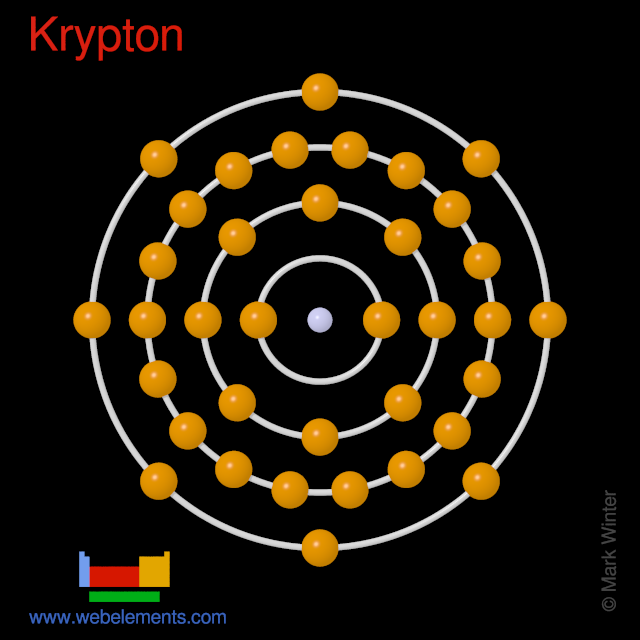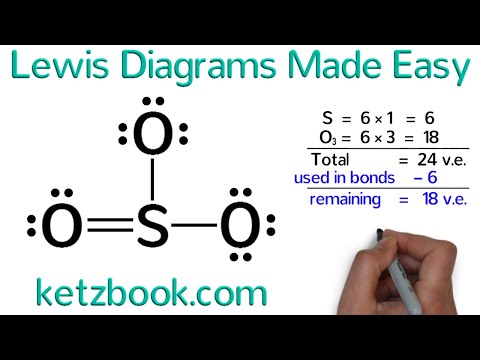- Kr Valence Electrons Number
- Condensed Electron Configuration Of Krypton
- Kr How Many Valence Electrons
- Kr Valence Electrons Worksheet
- Kr Valence Electrons Structure
84 Kr Electron configuration Ar 3d 1 0 4s 2 4p 6 CAS number: 7439-90-9 ChemSpider ID: 5223: ChemSpider is a free chemical. Kr 5s2 4d10 5p2. Tin (Sn) The largest division of the electron cloud, symbol is 'n'. States that atoms are most stable with 8 valence electrons. Electron Configuration of the elements. Text lists sorted by: Value Atomic Number. Kr5s 2: Berkelium Rn7s 2 5f 9: Yttrium Kr5s 2 4d 1: Californium Rn7s 2.
Which one of the following ions is iso-electronic with krypton? (a) #Ca^(2+)#, (b) #K^+# (c) #I^-# (d) #Mg^(2+)# (e) #Sr^(2+)#
1 Answer
The answer is e)
For an ion to be isoelectronic with an atom (or with another ion), it must have the same number of electrons surrounding its nucleus.
A quick examination of the periodic table will show that krypton,
This means that a neutral krypton atom has 36 electrons surrounding its nucleus. As a result, any species that is isoelectronic with krypton will have 36 electrons surrounding its nucleus as well.
Start with calcium,
Potassium, or
Iodine,
Magnesium,
Finally, strontium,
Related questions
Quantum Numbers,
Atomic Orbitals, and
Electron Configurations
Contents:
Quantum Numbers and Atomic Orbitals
1. Principal Quantum Number (n)
2.Angular Momentum (Secondary, Azimunthal) Quantum Number (l)
3.Magnetic Quantum Number (ml)
4.Spin Quantum Number (ms)
Table of Allowed Quantum Numbers
Writing Electron Configurations
Properties of Monatomic Ions
References
Quantum Numbers and Atomic Orbitals
By solving the Schrödinger equation (Hy = Ey), we obtain a set of mathematical equations, called wave functions (y), which describe the probability of finding electrons at certain energy levels within an atom.
A wave function for an electron in an atom is called an atomic orbital; this atomic orbital describes a region of space in which there is a high probability of finding the electron. Energy changes within an atom are the result of an electron changing from a wave pattern with one energy to a wave pattern with a different energy (usually accompanied by the absorption or emission of a photon of light).

Each electron in an atom is described by four different quantum numbers. The first three (n, l, ml) specify the particular orbital of interest, and the fourth (ms) specifies how many electrons can occupy that orbital.
- Principal Quantum Number (n): n = 1, 2, 3, …, ∞
Specifies the energy of an electron and the size of the orbital (the distance from the nucleus of the peak in a radial probability distribution plot). All orbitals that have the same value of n are said to be in the same shell (level). For a hydrogen atom with n=1, the electron is in its ground state; if the electron is in the n=2 orbital, it is in an excited state. The total number of orbitals for a given n value is n2.
- Angular Momentum (Secondary, Azimunthal) Quantum Number (l): l = 0, ..., n-1.
Specifies the shape of an orbital with a particular principal quantum number. The secondary quantum number divides the shells into smaller groups of orbitals called subshells (sublevels). Usually, a letter code is used to identify l to avoid confusion with n:
| l | 0 | 1 | 2 | 3 | 4 | 5 | ... |
| Letter | s | p | d | f | g | h | ... |
Kr Valence Electrons Number
The subshell with n=2 and l=1 is the 2p subshell; if n=3 and l=0, it is the 3s subshell, and so on. The value of l also has a slight effect on the energy of the subshell; the energy of the subshell increases with l (s < p < d < f).
- Magnetic Quantum Number (ml): ml = -l, ..., 0, ..., +l.
Specifies the orientation in space of an orbital of a given energy (n) and shape (l). This number divides the subshell into individual orbitals which hold the electrons; there are 2l+1 orbitals in each subshell. Thus the s subshell has only one orbital, the p subshell has three orbitals, and so on.
- Spin Quantum Number (ms): ms = +½ or -½.
Specifies the orientation of the spin axis of an electron. An electron can spin in only one of two directions (sometimes called up and down).
The Pauli exclusion principle (Wolfgang Pauli, Nobel Prize 1945) states that no two electrons in the same atom can have identical values for all four of their quantum numbers. What this means is that no more than two electrons can occupy the same orbital, and that two electrons in the same orbital must have opposite spins.
Because an electron spins, it creates a magnetic field, which can be oriented in one of two directions. For two electrons in the same orbital, the spins must be opposite to each other; the spins are said to be paired. These substances are not attracted to magnets and are said to be diamagnetic. Atoms with more electrons that spin in one direction than another contain unpaired electrons. These substances are weakly attracted to magnets and are said to be paramagnetic.
Table of Allowed Quantum Numbers
| n | l | ml | Number of orbitals | Orbital Name | Number of electrons |
| 1 | 0 | 0 | 1 | 1s | 2 |
| 2 | 0 | 0 | 1 | 2s | 2 |
| 1 | -1, 0, +1 | 3 | 2p | 6 | |
| 3 | 0 | 0 | 1 | 3s | 2 |
| 1 | -1, 0, +1 | 3 | 3p | 6 | |
| 2 | -2, -1, 0, +1, +2 | 5 | 3d | 10 | |
| 4 | 0 | 0 | 1 | 4s | 2 |
| 1 | -1, 0, +1 | 3 | 4p | 6 | |
| 2 | -2, -1, 0, +1, +2 | 5 | 4d | 10 | |
| 3 | -3, -2, -1, 0, +1, +2, +3 | 7 | 4f | 14 |
Writing Electron Configurations
The distribution of electrons among the orbitals of an atom is called the electron configuration. The electrons are filled in according to a scheme known as the Aufbau principle ('building-up'), which corresponds (for the most part) to increasing energy of the subshells:
1s, 2s, 2p, 3s, 3p, 4s, 3d, 4p, 5s, 4d, 5p, 6s, 4f, 5d, 6p, 7s, 5f
It is not necessary to memorize this listing, because the order in which the electrons are filled in can be read from the periodic table in the following fashion:
Or, to summarize:
In electron configurations, write in the orbitals that are occupied by electrons, followed by a superscript to indicate how many electrons are in the set of orbitals (e.g., H 1s1)
Another way to indicate the placement of electrons is an orbital diagram, in which each orbital is represented by a square (or circle), and the electrons as arrows pointing up or down (indicating the electron spin). When electrons are placed in a set of orbitals of equal energy, they are spread out as much as possible to give as few paired electrons as possible (Hund's rule).
examples will be added at a later date
In a ground state configuration, all of the electrons are in as low an energy level as it is possible for them to be. When an electron absorbs energy, it occupies a higher energy orbital, and is said to be in an excited state.
Properties of Monatomic Ions
The electrons in the outermost shell (the ones with the highest value of n) are the most energetic, and are the ones which are exposed to other atoms. This shell is known as the valence shell. The inner, core electrons (inner shell) do not usually play a role in chemical bonding.
Elements with similar properties generally have similar outer shell configurations. For instance, we already know that the alkali metals (Group I) always form ions with a +1 charge; the 'extra' s1 electron is the one that's lost:
| IA | Li | 1s22s1 | Li+ | 1s2 |
| Na | 1s22s22p63s1 | Na+ | 1s22s22p6 | |
| K | 1s22s22p63s23p64s1 | K+ | 1s22s22p63s23p6 |
The next shell down is now the outermost shell, which is now full — meaning there is very little tendency to gain or lose more electrons. The ion's electron configuration is the same as the nearest noble gas — the ion is said to be isoelectronic with the nearest noble gas. Atoms 'prefer' to have a filled outermost shell because this is more electronically stable.
- The Group IIA and IIIA metals also tend to lose all of their valence electrons to form cations.
| IIA | Be | 1s22s2 | Be2+ | 1s2 |
| Mg | 1s22s22p63s2 | Mg2+ | 1s22s22p6 | |
| IIIA | Al | 1s22s22p63s23p1 | Al3+ | 1s22s22p6 |

- The Group IV and V metals can lose either the electrons from the p subshell, or from both the s and p subshells, thus attaining a pseudo-noble gas configuration.
| IVA | Sn | [Kr]4d105s25p2 | Sn2+ | [Kr]4d105s2 |
| Sn4+ | [Kr]4d10 | |||
| Pb | [Xe]4f145d106s26p2 | Pb2+ | [Xe]4f145d106s2 | |
| Pb4+ | [Xe]4f145d10 | |||
| VA | Bi | [Xe]4f145d106s26p3 | Bi3+ | [Xe]4f145d106s2 |
| Bi5+ | [Xe]4f145d10 |
- The Group IV - VII non-metals gain electrons until their valence shells are full (8 electrons).
| IVA | C | 1s22s22p2 | C4- | 1s22s22p6 |
| VA | N | 1s22s22p3 | N3- | 1s22s22p6 |
| VIA | O | 1s22s22p4 | O2- | 1s22s22p6 |
| VIIA | F | 1s22s22p5 | F- | 1s22s22p6 |
- The Group VIII noble gases already possess a full outer shell, so they have no tendency to form ions.
- Transition metals (B-group) usually form +2 charges from losing the valence s electrons, but can also lose electrons from the highest d level to form other charges.
Condensed Electron Configuration Of Krypton

Kr How Many Valence Electrons
| B-group | Fe | 1s22s22p63s23p63d64s2 | Fe2+ | 1s22s22p63s23p63d6 |
| Fe3+ | 1s22s22p63s23p63d5 |
Kr Valence Electrons Worksheet
References
Martin S. Silberberg, Chemistry: The Molecular Nature of Matter and Change, 2nd ed. Boston: McGraw-Hill, 2000, p. 277-284, 293-307.
Kr Valence Electrons Structure

